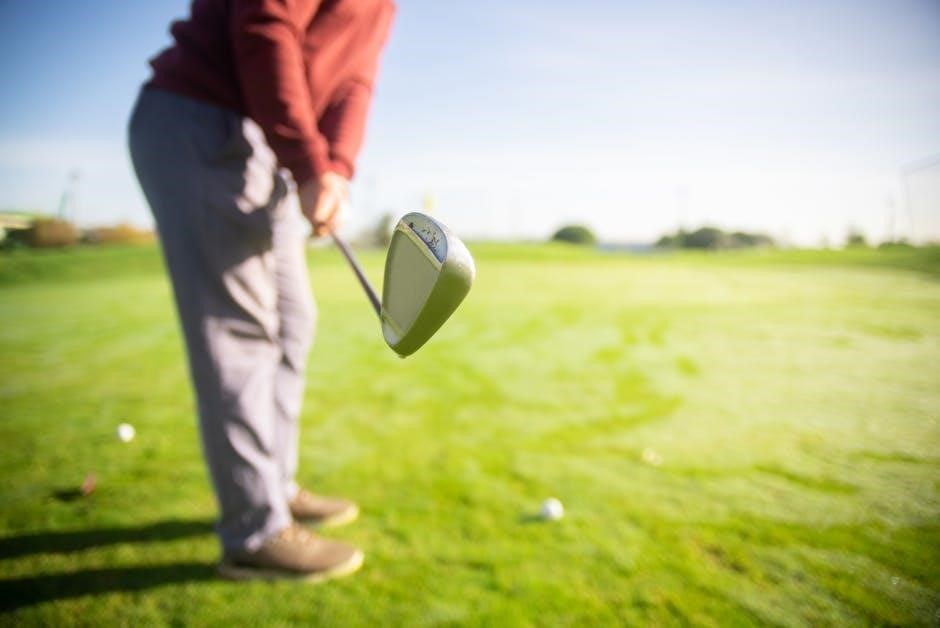Understanding Golf Club Types
Golf clubs are categorized into drivers, fairways, hybrids, irons, wedges, and putters. Each type serves a specific purpose, such as maximizing distance or improving accuracy. Understanding their roles enhances performance.
1.1 Drivers: Purpose and Selection
Drivers are designed to maximize distance off the tee. They feature large clubheads and long shafts for higher ball speed. When selecting, consider loft angles, forgiveness, and adjustability. Custom fitting ensures optimal performance based on swing speed and style. Graphite shafts offer lighter weight for faster swings, while steel shafts provide more control. Choosing the right driver enhances tee shot accuracy and overall game performance significantly.
1.2 Fairways, Hybrids, and Irons: Differences and Uses
Fairway woods are versatile, used for shots from the fairway or rough. Hybrids combine iron and wood features, offering forgiveness and distance. Irons provide precision and control for approach shots. Each club type varies in loft, size, and shaft length, catering to different swing styles and distances. Proper selection based on skill level and course conditions enhances gameplay and shot accuracy significantly.
1.3 Wedges and Putters: Importance in Short Game
Wedges and putters are essential for the short game, enabling precise shots near the green. Wedges, including pitching, sand, and lob wedges, help with high-angle shots and escaping bunkers. Putters ensure consistent ball roll on the green. Custom fitting these clubs enhances accuracy and control, making them indispensable for improving scores in critical scoring zones.
Choosing Clubs Based on Skill Level
Choosing clubs based on skill level is crucial. Beginners benefit from forgiveness and ease of use, while intermediates seek balance. Advanced players prioritize precision and workability, enhancing overall performance and satisfaction.
2.1 Beginner Clubs: Forgiveness and Ease of Use
Beginner clubs prioritize forgiveness and ease of use, ensuring consistent performance. Larger clubheads, cavity-back irons, and hybrid clubs reduce mishits. Lightweight shafts and flexible faces enhance distance. Forgiveness minimizes penalties, while simple designs promote confidence; These features help new golfers build technique and enjoy the game without frustration, making progress feel achievable and fun from the start.
2.2 Intermediate Clubs: Balancing Forgiveness and Control
Intermediate clubs offer a balance of forgiveness and control, catering to golfers refining their swing. They feature smaller clubheads and reduced offset for better accuracy. Forgiveness is maintained through mid-sized sweet spots, while weight distribution enhances feel. These clubs allow for more precise shots, helping intermediates improve consistency and accuracy without sacrificing distance, making them ideal for those advancing their skills and seeking better control over ball flight.
2.3 Advanced Clubs: Precision and Workability
Advanced clubs are designed for skilled golfers seeking precision and control. They typically feature smaller clubheads and less forgiveness, emphasizing workability for shaping shots. These clubs offer enhanced feel and feedback, allowing experienced players to manipulate ball flight and trajectory with ease. Custom fitting is crucial for optimal performance, as advanced clubs cater to specific swing characteristics and techniques, ensuring maximum accuracy and consistency on the course.
Importance of Custom Fitting
Custom fitting ensures clubs match your swing dynamics, improving performance and consistency. It tailors club length, lie, and loft to your unique needs for optimal accuracy and distance;
3.1 How Custom Fitting Works
Custom fitting involves analyzing a golfer’s swing speed, angle, and style. Professionals use specialized tools to measure these metrics and recommend club specifications that optimize performance. The process includes testing different club lengths, lie angles, and shaft flex to ensure a perfect match for the golfer’s technique, leading to improved accuracy and distance.
3.2 Benefits of Fitted Clubs for Performance
Fitted clubs significantly enhance performance by improving accuracy and distance. They reduce slicing and hooking, providing straighter shots. Customized clubs also boost confidence, as they are tailored to the golfer’s unique swing. This personalization leads to better control and consistency, making the game more enjoyable and rewarding for players of all skill levels.
Budgeting for Your Clubs
Setting a budget is crucial for golf club purchases. Prices vary widely, so understanding your spending limits ensures wise investment in quality equipment without financial strain.
4.1 Setting a Budget: What to Expect at Different Price Points
Golf club budgets vary significantly based on quality and technology. Entry-level sets start around $300, offering basic performance. Mid-range clubs, priced between $500–$1,200, provide better forgiveness and control. High-end sets, often exceeding $1,500, feature advanced materials and customization. Understanding these tiers helps golfers allocate resources effectively without overspending.
4.2 Tips for Finding Value and Avoiding Overspending
Consider used or last-season clubs for significant savings. Demo sets or rental clubs offer affordable trial periods. Prioritize custom fitting to avoid costly mismatches. Renting clubs for testing ensures compatibility. Look for sales, discounts, or price matching. Set a clear budget to avoid impulse purchases. These strategies help maximize value while staying financially disciplined.
Components of a Golf Club Set
A standard set includes drivers, fairways, hybrids, irons, wedges, and putters. Each club serves a unique role, ensuring versatility for various shots during a round.
5.1 Typical Composition of a Set
A standard golf club set includes 14 clubs: 1 driver, 1 fairway wood, 1 hybrid, 7 irons, 2 wedges, and 1 putter. This composition provides versatility for various shots, from long drives to precise putts, ensuring players are equipped for all scenarios on the course. Each club’s design and loft angle are tailored to specific distances and trajectories, offering a balanced approach to gameplay.
5.2 Prioritizing Clubs Based on Needs
Prioritizing clubs involves assessing skill level, swing characteristics, and personal preferences. Beginners may focus on forgiving clubs, while advanced players opt for precision. Budget allocation and the 14-club rule also influence decisions, ensuring the right tools for various shots and course conditions.

Shaft Type and Flex
Shaft type and flex significantly impact performance. Steel shafts offer durability and feedback, while graphite shafts are lighter for increased swing speed. Proper flex matches swing tempo for optimal ball flight and accuracy, enhancing overall play.
6.1 Materials: Steel vs. Graphite
Steel shafts are durable, provide consistent feedback, and suit stronger players, while graphite shafts are lighter, reduce vibration, and enhance swing speed for those seeking distance and comfort.
6.2 Flex Ratings and Their Impact on Swing
Flex ratings determine shaft stiffness, affecting swing dynamics. Proper flex ensures optimal energy transfer, consistent ball flight, and accuracy. Too stiff a shaft reduces power, while too flexible a shaft leads to inconsistent shots. Correct flex rating enhances swing efficiency, control, and overall performance, making it vital for golfers to choose based on their swing speed and style.

Clubhead Design and Technology
Modern clubheads feature multi-material construction, optimizing forgiveness and distance. Technologies like hollow bodies, internal weighting, and face inserts enhance performance, ensuring better accuracy and control for golfers.
7.1 Technology Behind Modern Clubheads
Modern clubheads leverage advanced materials like titanium and carbon fiber for reduced weight and increased strength. Internal structures, such as Speed Pockets and Face Insert technology, enhance ball speed and forgiveness. These innovations allow for larger sweet spots and improved energy transfer, resulting in longer, straighter shots. Customizable features also enable precise tuning for individual swing dynamics and preferences.
7.2 Adjustable Clubs: Pros and Cons
Adjustable clubs offer flexibility, allowing customization of loft, lie, and face angle to suit individual swings. This adaptability improves performance for golfers with changing techniques. However, adjustable clubs are often more expensive due to the added technology. Some golfers find the numerous settings confusing, potentially leading to improper adjustments and negatively impacting play. Balancing customization and simplicity is key for optimal results.
Purchasing Options: New vs. Used
New clubs offer the latest technology, warranties, and precise fitting, enhancing performance. Used clubs provide cost savings and access to premium models, though they may lack the newest innovations.
8.1 Pros and Cons of Buying New Clubs
New clubs offer cutting-edge technology, better performance, and custom fitting options. They come with warranties, ensuring quality and durability. However, they are more expensive and may not justify the cost for casual players, as last year’s models often perform similarly.
8.2 Benefits and Drawbacks of Used Clubs
Used clubs are budget-friendly and offer significant savings for golfers on a tight budget. They allow access to high-end technology at a lower cost. However, they may lack warranties, and their condition can vary. Finding the right fit is crucial, as used clubs might not align with your swing specifics or provide the latest advancements.

Brand and Model Selection
Top brands like Callaway, TaylorMade, and Titleist offer advanced technology and specialized features. Research models to find the best fit for your swing and preferences, ensuring optimal performance.
9.1 Top Brands and Their Specializations
Top brands like Callaway, TaylorMade, and Titleist specialize in innovative club designs. Callaway excels in forgiveness and distance, while TaylorMade focuses on aerodynamics and adjustability. Titleist emphasizes precision and feel. Ping offers customization, Mizuno is known for irons, and Cobra provides versatile options. Each brand caters to different skill levels, ensuring a tailored approach for every golfer’s needs and preferences, enhancing overall performance on the course.
9.2 Researching Models for Best Fit
Researching golf club models involves matching your swing characteristics and skill level with the right equipment. Consider custom fitting, as it ensures clubs are tailored to your needs. Test clubs on the course or at a pro shop to gauge performance. Read reviews and seek recommendations from PGA professionals to make informed decisions, ensuring the best fit for optimal performance and satisfaction.

Maintaining Your Clubs
Proper maintenance involves regular cleaning, storing clubs in a dry place, and inspecting for wear; This ensures longevity and optimal performance on the course.
10.1 Cleaning and Storage Tips
Regularly clean clubs with mild soap and water, avoiding harsh chemicals. Store them in a dry place, ideally in a golf bag. Keep clubheads and shafts dry to prevent rust. Avoid extreme temperatures and moisture. Clean grooves after each round for optimal performance. Organize clubs by type for easy access. Proper care extends the life of your golf clubs and maintains their performance quality over time.
10.2 Regular Maintenance for Longevity
- Inspect clubs regularly for wear and tear, especially grooves and shafts.
- Replace worn grips to maintain consistent control and feel.
- Ensure clubheads are securely attached to shafts to prevent loosening.
- Avoid exposing clubs to extreme temperatures or harsh chemicals.
- Use a ball cleaner to remove dirt and debris after each round.
- Store clubs properly to prevent damage and extend their lifespan.
Warranties and After-Sales Support
Warranties protect against defects, ensuring club longevity. Brands often provide dedicated support, enhancing customer satisfaction and trust in their products.
11.1 What to Look for in a Warranty
When evaluating a warranty, consider coverage duration, scope of defects covered, and ease of claims. Look for clear terms, including repair or replacement options. Ensure the warranty aligns with your needs and the club’s expected lifespan. A reputable brand’s warranty often reflects confidence in product quality and durability.
11.2 Importance of Brand Support
Brand support is crucial for post-purchase assistance and maintaining club performance. Reputable brands offer reliable customer service, troubleshooting, and access to genuine parts. Strong brand support ensures longevity of equipment and enhances overall satisfaction. It also provides peace of mind, knowing help is available when issues arise.
Post-Purchase: Getting Familiar with Your Clubs
Familiarizing yourself with your clubs post-purchase is essential. Practice regularly to build confidence and consistency. Consider lessons from a PGA Pro to optimize your new equipment’s potential.
12.1 Practicing with New Clubs
Practicing with new clubs is crucial for adapting to their feel and performance. Start with short sessions at the driving range to build familiarity. Focus on swing consistency and ball flight patterns. Gradually incorporate on-course practice to test clubs in real scenarios. This routine helps refine your technique and maximizes the potential of your new equipment.
12.2 Considering Lessons for Maximizing Performance
Lessons from a PGA professional can significantly enhance your game when using new clubs. A coach provides personalized feedback, helping you adapt to the equipment’s unique feel and performance. Lessons focus on optimizing swing mechanics, ensuring proper club usage, and improving overall technique. This investment accelerates progress, helping you unlock the full potential of your custom-fit clubs and achieve consistent, better scores.